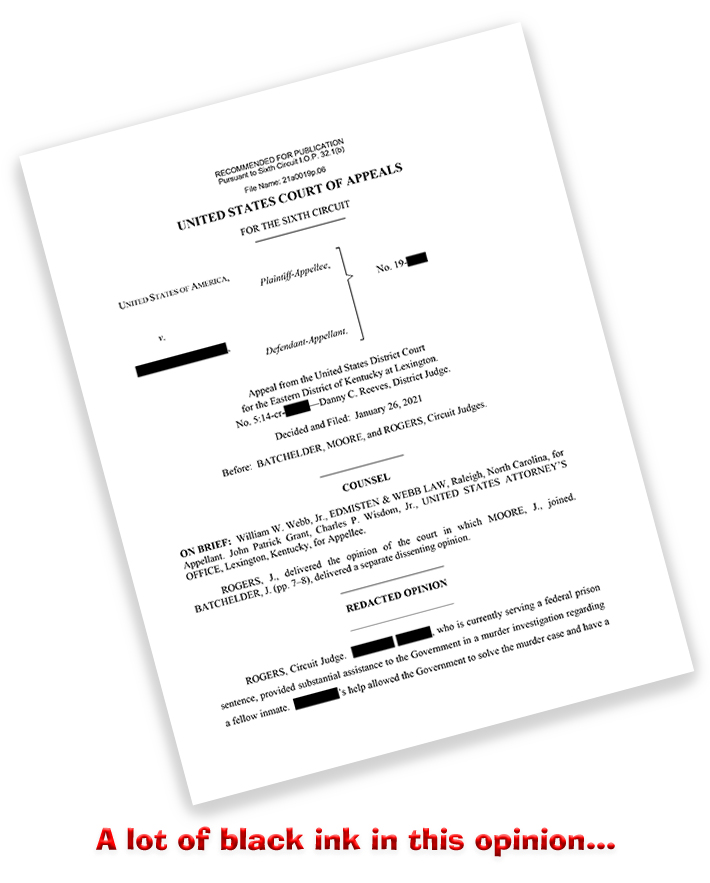We post news and comment on federal criminal justice issues, focused primarily on trial and post-conviction matters, legislative initiatives, and sentencing issues.

… MY FRIEND
 This week, a pair of cases admonishing judges that haste makes waste.
This week, a pair of cases admonishing judges that haste makes waste.
John Doe (and I call him that because the court redacted his name and case number, something that you don’t see very much) was doing 151 months for a drug case. While locked up, John convinced his cellie to admit to killing his stepdaughter, a crime the cellmate was suspected but not charged with. The guy did so, and got life from the state. The government filed a motion to reduce John’s sentence under F.R.Crim.P. 35(b), asking for 12-18 months off.
The same day the motion was filed, the district judge granted it, cutting the 151-month sentence by a mere 12 months. John appealed, and last week the 6th Circuit reversed.
 The district court erred, the Circuit ruled, in granting the Rule 35(b) without giving John an opportunity to respond to the Government’s motion. “In granting the Government’s motion and deciding on the amount of reduction on the same day that the motion was filed,” the Circuit held, “the court denied John an opportunity to provide his own recommendation and present argument and accompanying evidence regarding the sentence reduction that he believed was warranted for his substantial assistance… a court does not, merely by agreeing with the Government’s assessment of the value of the assistance provided, thereby disavow its statutory discretion, particularly when the defendant has not provided his own recommendation concerning the value of that assistance and does not dispute the government’s description of his assistance.”
The district court erred, the Circuit ruled, in granting the Rule 35(b) without giving John an opportunity to respond to the Government’s motion. “In granting the Government’s motion and deciding on the amount of reduction on the same day that the motion was filed,” the Circuit held, “the court denied John an opportunity to provide his own recommendation and present argument and accompanying evidence regarding the sentence reduction that he believed was warranted for his substantial assistance… a court does not, merely by agreeing with the Government’s assessment of the value of the assistance provided, thereby disavow its statutory discretion, particularly when the defendant has not provided his own recommendation concerning the value of that assistance and does not dispute the government’s description of his assistance.”
The judge in this district court travesty was none other than our perennial troglodyte jurist, the Honorable Danny C. Reeves, a guy whose sentencing screw-ups have graced this blog before (such as here and here). What’s so frightening is that then-President Trump nominated this knuckle-dragger to serve on the Sentencing Commission. But I digress.
Meanwhile, in the 4th Circuit, three defendants filed Sec. 404 motions for the retroactive crack reduction. In what must seem like getting a pair of socks for Christmas, the district court their motions on a standard “AO 247” form (in which the judge just checked the box for “granted” without explanation) but then reduced the supervised release terms of each by one year without cutting any time from the prison sentences. Each defendant appealed, and last week, the Court vacated the reductions and send the cases back.
There is a presumption, the Circuit said, that a district court sufficiently considers all relevant factors in a resentencing motion, but that presumption is rebuttable. In this case, the defendants all presented evidence of their extensive coursework and exemplary prison conduct, “mitigating evidence that was not available at their initial sentencing hearing… “The presentation of post-sentencing mitigation evidence in each of the motions is sufficient to rebut the… presumption that the district court, in fact, considered all of the relevant evidence.”
 The government argued that there was nothing special about the defendant’s post-sentencing conduct. Not so, said the 4th: the defendants “here have each spent nearly two decades in prison where, despite lengthy prison terms, they utilized the resources and programming they could access in prison to work toward rehabilitation… That kind of post-sentencing mitigating evidence is enough to require a district court to provide an explanation on the record of its reasons for deciding a sentencing reduction motion.”
The government argued that there was nothing special about the defendant’s post-sentencing conduct. Not so, said the 4th: the defendants “here have each spent nearly two decades in prison where, despite lengthy prison terms, they utilized the resources and programming they could access in prison to work toward rehabilitation… That kind of post-sentencing mitigating evidence is enough to require a district court to provide an explanation on the record of its reasons for deciding a sentencing reduction motion.”
United States v. [Redacted], Case No 19-[redacted], 2021 U.S. App. LEXIS 2306 (6th Cir. Jan 26 2021)
United States v. McDonald, Case No 19-7668, 2021 U.S. App. LEXIS 1827 (4th Cir Jan 22, 2021)
– Thomas L. Root

